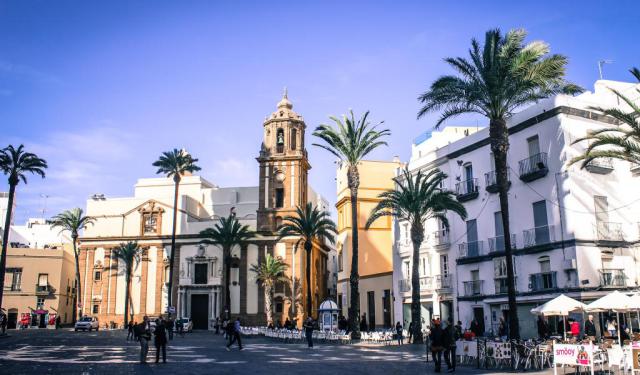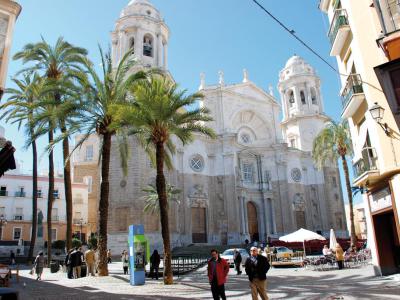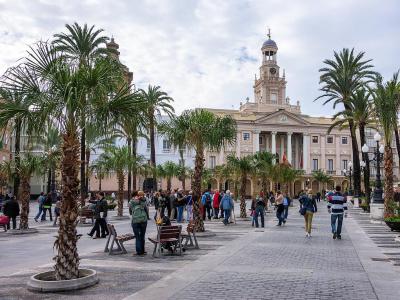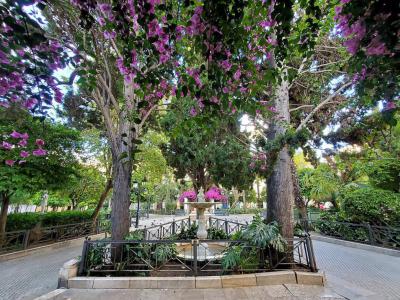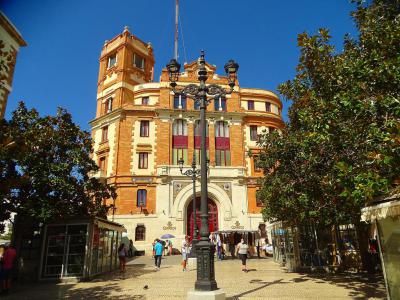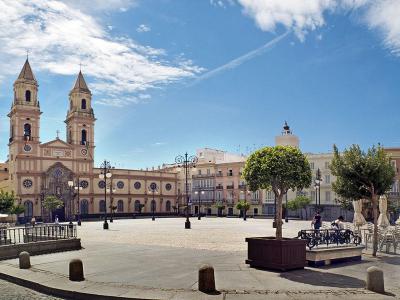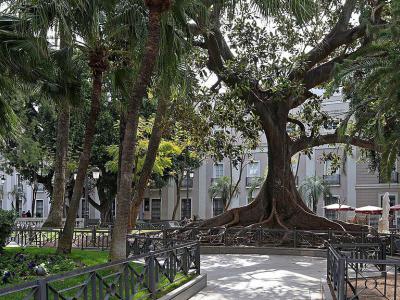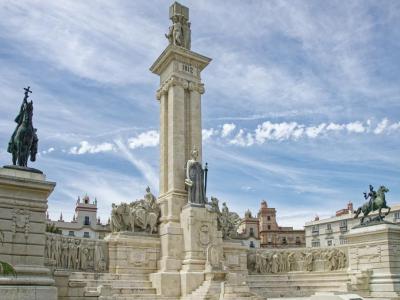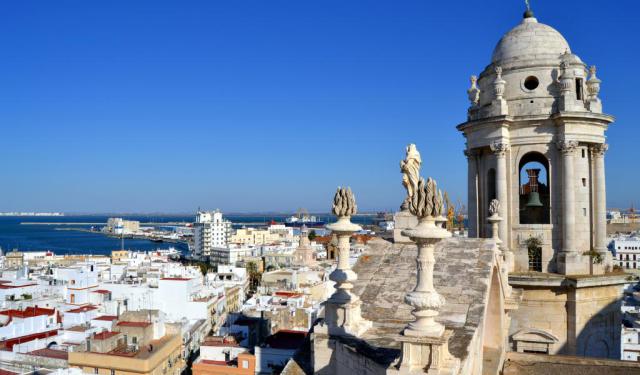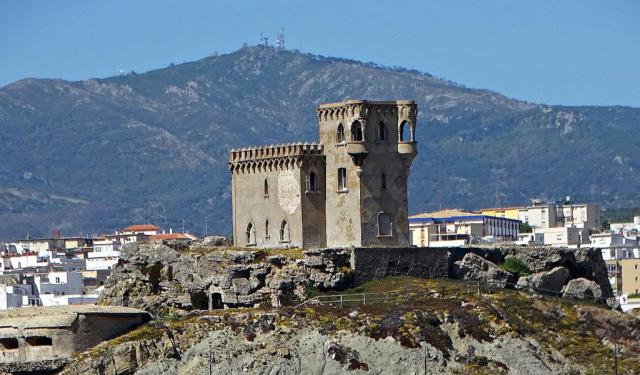Cadiz's Plazas Walking Tour (Self Guided), Cadiz
Nicknamed “the silver cup” for the way its peninsula juts into the Atlantic, Cádiz sparkles as one of Spain’s oldest coastal gems. The Old Town is a maze of narrow streets, whitewashed façades, and balconies that seem to compete over who can grow the brightest gardens. Add in centuries of Moorish, Baroque, and Neoclassical influence, and you’ve got a city that wears its history in layers of stone, color, and charm.
But the real soul of Cádiz lives in its plazas-those open-air living rooms where life spills out under palm trees and café umbrellas. Each one has its own personality, and together they tell the city’s story better than any guidebook.
Right on the seaside, the Cathedral and its square, where the golden dome and twin towers preside over music, chatter, and clinking coffee cups. Just a stroll away is Saint John of God Square , stretching in front of the Old Town Hall. With fountains and benches aplenty, it’s been welcoming both locals and port traffic for centuries.
If you’re in the mood for something quieter, Candelaria Square delivers orange trees, a central statue, and 19th-century façades that invite you to slow down. On the flip side, Flower Square is all bustle: flower stalls in the middle, fried fish kiosks around the edges, and the market pulling in a constant stream of people.
For grandeur, Saint Antonio Square fits the bill with its church, elegant mansions, and a knack for transforming into a festival ground. Mina Square leans greener, shaded by tall trees and watched over by the Cádiz Museum-perfect for families and students. And then there’s Square of Spain, opening to the harbor with a sweeping memorial to the Constitution of 1812, sculptures and steps that double as both history lesson and photo opportunity.
There’s an old saying here: “A full square makes for a happy heart.” In Cádiz, that rings true. Strolling from square to square isn’t just sightseeing-it’s stepping into the rhythm of a city where gathering has always been an art form.
But the real soul of Cádiz lives in its plazas-those open-air living rooms where life spills out under palm trees and café umbrellas. Each one has its own personality, and together they tell the city’s story better than any guidebook.
Right on the seaside, the Cathedral and its square, where the golden dome and twin towers preside over music, chatter, and clinking coffee cups. Just a stroll away is Saint John of God Square , stretching in front of the Old Town Hall. With fountains and benches aplenty, it’s been welcoming both locals and port traffic for centuries.
If you’re in the mood for something quieter, Candelaria Square delivers orange trees, a central statue, and 19th-century façades that invite you to slow down. On the flip side, Flower Square is all bustle: flower stalls in the middle, fried fish kiosks around the edges, and the market pulling in a constant stream of people.
For grandeur, Saint Antonio Square fits the bill with its church, elegant mansions, and a knack for transforming into a festival ground. Mina Square leans greener, shaded by tall trees and watched over by the Cádiz Museum-perfect for families and students. And then there’s Square of Spain, opening to the harbor with a sweeping memorial to the Constitution of 1812, sculptures and steps that double as both history lesson and photo opportunity.
There’s an old saying here: “A full square makes for a happy heart.” In Cádiz, that rings true. Strolling from square to square isn’t just sightseeing-it’s stepping into the rhythm of a city where gathering has always been an art form.
How it works: Download the app "GPSmyCity: Walks in 1K+ Cities" from Apple App Store or Google Play Store to your mobile phone or tablet. The app turns your mobile device into a personal tour guide and its built-in GPS navigation functions guide you from one tour stop to next. The app works offline, so no data plan is needed when traveling abroad.
Cadiz's Plazas Walking Tour Map
Guide Name: Cadiz's Plazas Walking Tour
Guide Location: Spain » Cadiz (See other walking tours in Cadiz)
Guide Type: Self-guided Walking Tour (Sightseeing)
# of Attractions: 7
Tour Duration: 1 Hour(s)
Travel Distance: 1.9 Km or 1.2 Miles
Author: DanaOffice
Sight(s) Featured in This Guide:
Guide Location: Spain » Cadiz (See other walking tours in Cadiz)
Guide Type: Self-guided Walking Tour (Sightseeing)
# of Attractions: 7
Tour Duration: 1 Hour(s)
Travel Distance: 1.9 Km or 1.2 Miles
Author: DanaOffice
Sight(s) Featured in This Guide:
- Cadiz Cathedral and Square
- Plaza de San Juan de Dios (Saint John of God Square) and Old Town Hall
- Plaza de la Candelaria (Candelaria Square)
- Plaza de Las Flores (Flower Square)
- Plaza de San Antonio (San Antonio Square)
- Plaza de Mina (Mina Square)
- Plaza de España (Square of Spain)
1) Cadiz Cathedral and Square (must see)
The 18th century was Cádiz’s golden era-literally. Gold from the Americas was flowing in, wigs were high, and civic pride was even higher. So naturally, the city decided it needed a cathedral that didn’t just rival Seville’s-it had to outshine the Giralda, Seville's precious tower.
After the original architect stormed off in 1739, a tag-team of architects spanning nearly a century followed, each adding their own stylistic flair. The result was a cathedral that pirouettes from Baroque to Rococo to Neoclassical like it couldn’t make up its mind. Surprisingly or not, the cathedral ended up looking fabulous.
The layout follows the traditional cross shape, with three main aisles and a walkway that curves around the altar like a quiet loop. Rows of polished Corinthian columns hold up elegant vaulted ceilings, and there's a crypt downstairs big enough to make any vampire rethink retirement. The altar sits high and proud, commanding your gaze, while above it all, a dome crowns the space like a golden exclamation mark. And in the choir loft? Not one, but two powerful organs-more than enough to fill the church (and your spine) with musical thunder.
Nevertheless, the main showpiece is the Clock Tower, also known as the Levante Tower. Standing at 184 feet tall, it’s your best bet for sweeping views of the El Pópulo district, the Field of the South, and the harbor, with the Atlantic winking in the distance.
The Cathedral Square outside wasn’t always so open and grand-it was created during Cádiz’s 1721 urban makeover, which included demolishing a few modest houses to make room for this dramatic entrance. The square runs along the seafront and is paved in white marble, because if you're going to build a cathedral this extra, your plaza needs to match.
Don't miss the Rose Arch, which once led to the old Tablas Square and now serves as a charming pass-through to the Town Castle. Within the square itself, you’ll also find the Church of Santa Cruz (the old cathedral from 1669) and the Jesuit Church of Santiago, built in 1563 and still standing tall.
After the original architect stormed off in 1739, a tag-team of architects spanning nearly a century followed, each adding their own stylistic flair. The result was a cathedral that pirouettes from Baroque to Rococo to Neoclassical like it couldn’t make up its mind. Surprisingly or not, the cathedral ended up looking fabulous.
The layout follows the traditional cross shape, with three main aisles and a walkway that curves around the altar like a quiet loop. Rows of polished Corinthian columns hold up elegant vaulted ceilings, and there's a crypt downstairs big enough to make any vampire rethink retirement. The altar sits high and proud, commanding your gaze, while above it all, a dome crowns the space like a golden exclamation mark. And in the choir loft? Not one, but two powerful organs-more than enough to fill the church (and your spine) with musical thunder.
Nevertheless, the main showpiece is the Clock Tower, also known as the Levante Tower. Standing at 184 feet tall, it’s your best bet for sweeping views of the El Pópulo district, the Field of the South, and the harbor, with the Atlantic winking in the distance.
The Cathedral Square outside wasn’t always so open and grand-it was created during Cádiz’s 1721 urban makeover, which included demolishing a few modest houses to make room for this dramatic entrance. The square runs along the seafront and is paved in white marble, because if you're going to build a cathedral this extra, your plaza needs to match.
Don't miss the Rose Arch, which once led to the old Tablas Square and now serves as a charming pass-through to the Town Castle. Within the square itself, you’ll also find the Church of Santa Cruz (the old cathedral from 1669) and the Jesuit Church of Santiago, built in 1563 and still standing tall.
2) Plaza de San Juan de Dios (Saint John of God Square) and Old Town Hall
Saint John of God Square-or as locals call it, La Corredera-is Cádiz’s front porch, living room, and civic stage all rolled into one. Originally laid out in the 15th century, when Columbus was still just doodling ship ideas, the square was built just outside the old city walls. Back then, Cádiz was a cluster of sandy islands, and this area was a sea-splashed stretch of reclaimed land.
Entry came via the sea-facing gate, now charmingly known as the Arch of the People-because nothing says “democratic access” like a once-fortified gateway.
By the 18th century, things were getting crowded, and the old Consistorial Houses-essentially the city’s early bureaucratic digs-were torn down to make way for something a bit grander. The current Town Hall took shape, with a Neoclassical heart and, in 1865, a bit of Gothic flair. Moreover, an Isabelline-style façade was added, topped with a pediment that features none other than Hercules, flexing his mythological credentials as the alleged founder of Gadeira-Cádiz’s ancient alter ego.
And if that name sounds old, it should. By the time Hannibal showed up during the Second Punic War (218 to 201 BC), Cádiz was already centuries into its coastal career. As far as ancient cities go, Cádiz doesn’t just have history-it remembers it.
Today, the square is less about defending the harbor and more about sipping coffee under the palms while the Town Hall keeps an eye on things-just as it’s done for generations.
Entry came via the sea-facing gate, now charmingly known as the Arch of the People-because nothing says “democratic access” like a once-fortified gateway.
By the 18th century, things were getting crowded, and the old Consistorial Houses-essentially the city’s early bureaucratic digs-were torn down to make way for something a bit grander. The current Town Hall took shape, with a Neoclassical heart and, in 1865, a bit of Gothic flair. Moreover, an Isabelline-style façade was added, topped with a pediment that features none other than Hercules, flexing his mythological credentials as the alleged founder of Gadeira-Cádiz’s ancient alter ego.
And if that name sounds old, it should. By the time Hannibal showed up during the Second Punic War (218 to 201 BC), Cádiz was already centuries into its coastal career. As far as ancient cities go, Cádiz doesn’t just have history-it remembers it.
Today, the square is less about defending the harbor and more about sipping coffee under the palms while the Town Hall keeps an eye on things-just as it’s done for generations.
3) Plaza de la Candelaria (Candelaria Square)
Candelaria Square is one of Cádiz’s oldest gathering spots-and it isn’t shy about showing its age in style. Its trapezoid shape already sets it apart, but what really charms visitors are the layers of greenery. On the outside edge, tall elms once ruled the scene, though these days they’re slowly giving way to hackberry trees. Step closer in, and a neat row of bitter orange trees perfumes the air each spring, filling the square with the unmistakable scent of orange blossoms.
The center is dotted with eye-catching tree specimens that create a leafy contrast against the 19th-century houses ringing the square. Most of these buildings lean into Romantic-era elegance, though a few show off their quirks. House No. 15, known as the Oviedo Asylum, shows off Elizabethan style, with columns and stone supports decorated with carved eagles. House No. 6, built in 1906, goes modern for its time, blending iron and glass with confidence.
Anchoring the square is its most distinct feature: a bronze statue of Emilio Castelar, the eloquent politician, journalist, historian-and last president of Spain’s short-lived First Republic. Sculpted in 1906, Castelar still holds the floor from the center of the plaza, a reminder of Cádiz’s political and cultural ties.
Once part of the Monastery of La Candelaria, the site transformed after the monastery’s demolition into the spacious square we see today. Locals have been strolling here for generations, and visitors quickly catch on to its charms.
The center is dotted with eye-catching tree specimens that create a leafy contrast against the 19th-century houses ringing the square. Most of these buildings lean into Romantic-era elegance, though a few show off their quirks. House No. 15, known as the Oviedo Asylum, shows off Elizabethan style, with columns and stone supports decorated with carved eagles. House No. 6, built in 1906, goes modern for its time, blending iron and glass with confidence.
Anchoring the square is its most distinct feature: a bronze statue of Emilio Castelar, the eloquent politician, journalist, historian-and last president of Spain’s short-lived First Republic. Sculpted in 1906, Castelar still holds the floor from the center of the plaza, a reminder of Cádiz’s political and cultural ties.
Once part of the Monastery of La Candelaria, the site transformed after the monastery’s demolition into the spacious square we see today. Locals have been strolling here for generations, and visitors quickly catch on to its charms.
4) Plaza de Las Flores (Flower Square)
Flower Square does exactly what it seems like-it’s the spot in Cádiz where blossoms take center stage. The central stalls overflow with color, giving the square its perfume and energy. During Carnival, it cranks up even further, as street theaters and performances spill into the area, turning the whole square into one big stage.
But there’s more here than flowers and festivities. This space once belonged to the Convent of the Shoeless, which eventually gave way to something very different: the Post Office and Telegraph building, opened in 1930. Built of brick and dressed with shiny ceramic details, it’s a fine example of the eclectic regionalist (tile and decorative brickwork mix) style, standing out against the more traditional Cádiz architecture nearby.
The square also keeps its share of older treasures. Building No. 1, dating back to 1746, shows off a classic Baroque façade, with decorative pilasters that make the front look both grand and dramatic. Then there’s Building No. 12, designed by local architect Torcuato Benjumeda in a neat neoclassical style, with giant Doric pilasters that give it a strong, imposing look. Together, these buildings mix centuries of design into one compact plaza.
Flower Square may be known for its blooms, but it’s just as much about layers of history and a backdrop that blends Baroque curves, neoclassical order, and 20th-century flair. Stop by for the flowers, stay for the architecture, maybe you'll be lucky enough to catch the Carnival as well.
But there’s more here than flowers and festivities. This space once belonged to the Convent of the Shoeless, which eventually gave way to something very different: the Post Office and Telegraph building, opened in 1930. Built of brick and dressed with shiny ceramic details, it’s a fine example of the eclectic regionalist (tile and decorative brickwork mix) style, standing out against the more traditional Cádiz architecture nearby.
The square also keeps its share of older treasures. Building No. 1, dating back to 1746, shows off a classic Baroque façade, with decorative pilasters that make the front look both grand and dramatic. Then there’s Building No. 12, designed by local architect Torcuato Benjumeda in a neat neoclassical style, with giant Doric pilasters that give it a strong, imposing look. Together, these buildings mix centuries of design into one compact plaza.
Flower Square may be known for its blooms, but it’s just as much about layers of history and a backdrop that blends Baroque curves, neoclassical order, and 20th-century flair. Stop by for the flowers, stay for the architecture, maybe you'll be lucky enough to catch the Carnival as well.
5) Plaza de San Antonio (San Antonio Square)
San Antonio Square has long been one of Cádiz’s beating hearts. Back in the day it was called the Field of Rockrose, but its fortunes changed in the 1600s when a small hermitage to Saint Antonio popped up-and gave the square its current name. A nearby well kept Cádiz hydrated for years, making this more than just a meeting spot; it was survival central.
By the 18th century, the square had grown into a proper hub for trade, faith, and politics. It was here that Spain’s landmark Constitution of 1812 was proclaimed-and, not so long after, where the liberal movement of 1820 met its violent end. In short, if Cádiz had breaking news, chances are it was announced-or crushed-right here.
The architecture around the square keeps the drama going. The façades show a neat uniformity, except for the slimmer outline of the Church of Saint Antonio, which still draws the eye. The Gaditano Casino, an 18th-century Baroque beauty, was later remodeled during the reign of Queen Isabel II, giving it a 19th-century makeover that mixed Romantic and revival styles. Step inside and you’ll also find Moorish-inspired decorations added in 1890.
Then there’s the old Aramburu Bank, sporting a white marble front from the 1700s but modernized with a splash of early 20th-century style. Add to that the House Museum of writer José María Pemán, once the home of Cádiz’s celebrated literary figure, and the square becomes part open-air gallery, part history book.
Today, San Antonio Square is more than a patch of paving stones-it’s where Cádiz layers faith, politics, and artistry into one lively setting. Sit at a café, look up at the façades, and you’re not just in a square-you’re sitting in the middle of four centuries of stories.
By the 18th century, the square had grown into a proper hub for trade, faith, and politics. It was here that Spain’s landmark Constitution of 1812 was proclaimed-and, not so long after, where the liberal movement of 1820 met its violent end. In short, if Cádiz had breaking news, chances are it was announced-or crushed-right here.
The architecture around the square keeps the drama going. The façades show a neat uniformity, except for the slimmer outline of the Church of Saint Antonio, which still draws the eye. The Gaditano Casino, an 18th-century Baroque beauty, was later remodeled during the reign of Queen Isabel II, giving it a 19th-century makeover that mixed Romantic and revival styles. Step inside and you’ll also find Moorish-inspired decorations added in 1890.
Then there’s the old Aramburu Bank, sporting a white marble front from the 1700s but modernized with a splash of early 20th-century style. Add to that the House Museum of writer José María Pemán, once the home of Cádiz’s celebrated literary figure, and the square becomes part open-air gallery, part history book.
Today, San Antonio Square is more than a patch of paving stones-it’s where Cádiz layers faith, politics, and artistry into one lively setting. Sit at a café, look up at the façades, and you’re not just in a square-you’re sitting in the middle of four centuries of stories.
6) Plaza de Mina (Mina Square)
Step into Mina Square, and you’re stepping into a slice of 19th-century Cádiz that still knows how to charm. Once the property of the Catholic Church, the land was turned over to the public in the mid-1800s, complete with a monument to war hero Espoz y Mina. The monument eventually disappeared through later rebuilds, but the name and the spirit stuck.
The square is shaded by palms and other tall trees, making it a natural refuge when the Andalusian sun gets serious. Around its edges stand stately 19th-century buildings, reminders of a period when Cádiz was flexing both its cultural and architectural muscles. Look closely, and you’ll spot the plaque marking the birthplace of composer Manuel de Falla, one of Spain’s most celebrated musical minds.
Dominating the eastern side is the Museum of Cádiz, where archaeology, ethnography, and fine art share the stage. Its prize pieces-the Phoenician sarcophagi-connect today’s visitors with Cádiz’s deep ancient roots, while the galleries upstairs bring together Spanish painting and sculpture in ways that surprise as much as they educate.
Beyond the square itself, location is everything. Mina Square sits in the thick of downtown, only a short stroll from Plaza de España, the Saint Francis Convent, and the port. Think of it as both a destination in its own right and a convenient launch pad for exploring the rest of the city.
With leafy paths, historic façades, and culture packed into every corner, Mina Square proves that even in a city famous for its beaches and plazas, there’s always room for another favorite.
The square is shaded by palms and other tall trees, making it a natural refuge when the Andalusian sun gets serious. Around its edges stand stately 19th-century buildings, reminders of a period when Cádiz was flexing both its cultural and architectural muscles. Look closely, and you’ll spot the plaque marking the birthplace of composer Manuel de Falla, one of Spain’s most celebrated musical minds.
Dominating the eastern side is the Museum of Cádiz, where archaeology, ethnography, and fine art share the stage. Its prize pieces-the Phoenician sarcophagi-connect today’s visitors with Cádiz’s deep ancient roots, while the galleries upstairs bring together Spanish painting and sculpture in ways that surprise as much as they educate.
Beyond the square itself, location is everything. Mina Square sits in the thick of downtown, only a short stroll from Plaza de España, the Saint Francis Convent, and the port. Think of it as both a destination in its own right and a convenient launch pad for exploring the rest of the city.
With leafy paths, historic façades, and culture packed into every corner, Mina Square proves that even in a city famous for its beaches and plazas, there’s always room for another favorite.
7) Plaza de España (Square of Spain)
Square of Spain is Cádiz’s mix of sunshine, history, and political drama-basically an outdoor living room with better architecture. Its centerpiece is a gleaming white monument to the Spanish Constitution of 1812, one of Europe’s first written constitutions and a big deal for Cádiz, which hosted its signing. The design is no slouch, representing two bronze horsemen symbolizing war and peace, plus a heroic Hercules, the city’s mythic mascot, keeping watch over it all.
But the monument isn’t the only show here. The Customs Palace, with its imposing neoclassical façade and heavy columns, still struts its stuff as the provincial government’s headquarters. Then there’s the House of the Five Towers-literally five connected houses, each topped with its own little watchtower. Built in the late 1700s, it’s a textbook example of Cádiz architecture on the cusp of change, shifting from elaborate Baroque to the cleaner lines of Neoclassicism.
On the north side, the San Carlos neighborhood frames the square with elegant 18th-century homes, their façades reflecting the city’s golden age of trade and power. All of it sits around leafy parkland, where benches invite you to imagine what life looked like here two centuries ago.
The best part about the square is you don’t need a history degree to enjoy it-just a good pair of sunglasses and maybe an ice cream in hand.
But the monument isn’t the only show here. The Customs Palace, with its imposing neoclassical façade and heavy columns, still struts its stuff as the provincial government’s headquarters. Then there’s the House of the Five Towers-literally five connected houses, each topped with its own little watchtower. Built in the late 1700s, it’s a textbook example of Cádiz architecture on the cusp of change, shifting from elaborate Baroque to the cleaner lines of Neoclassicism.
On the north side, the San Carlos neighborhood frames the square with elegant 18th-century homes, their façades reflecting the city’s golden age of trade and power. All of it sits around leafy parkland, where benches invite you to imagine what life looked like here two centuries ago.
The best part about the square is you don’t need a history degree to enjoy it-just a good pair of sunglasses and maybe an ice cream in hand.
Walking Tours in Cadiz, Spain
Create Your Own Walk in Cadiz
Creating your own self-guided walk in Cadiz is easy and fun. Choose the city attractions that you want to see and a walk route map will be created just for you. You can even set your hotel as the start point of the walk.
Cadiz Introduction Walking Tour
Cádiz isn’t just old-it’s mythologically old. Some say Hercules himself founded the city after his tenth labor, fresh from slaying a three-headed monster and stealing a herd of red cattle. Others-less into mythology, more into maritime records-say it was the Phoenicians who rolled up in black ships around 1100 BC and named it Gadir, meaning “walled stronghold.” Either way, it’s been... view more
Tour Duration: 2 Hour(s)
Travel Distance: 2.8 Km or 1.7 Miles
Tour Duration: 2 Hour(s)
Travel Distance: 2.8 Km or 1.7 Miles
Cadiz's Old Fortifications Walking Tour
“Cádiz is a silver cup, surrounded by walls and kissed by the sea.” The saying isn’t just poetry-it’s urban planning. For over 3,000 years, this port city has been circling itself with stone, preparing for whoever might come sailing over the horizon. And given Cádiz’s enviable position and wealth, plenty of enemies did.
After Columbus launched voyages two and four from here,... view more
Tour Duration: 2 Hour(s)
Travel Distance: 4.3 Km or 2.7 Miles
After Columbus launched voyages two and four from here,... view more
Tour Duration: 2 Hour(s)
Travel Distance: 4.3 Km or 2.7 Miles
The Most Popular Cities
/ view all
